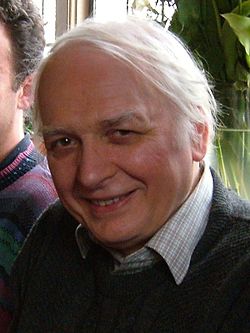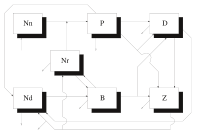- Michael Fasham
-
Michael Fasham 
In March 2004Born Michael John Robert Fasham
May 29, 1942
Edgware, United KingdomDied June 7, 2008 (aged 66) Residence Grayshott, England Nationality British Fields Oceanographer, ecosystem modelling Institutions National Institute of Oceanography (NIO), National Oceanography Centre, Southampton (NOCS) Alma mater Kilburn Grammar School, University of Birmingham Notable awards Challenger Society Medal (2002)
ASLO John Martin Award (2010)Notes
Fellow of the Royal SocietyMichael John Robert Fasham, FRS (May 29, 1942 – June 7, 2008)[1] was a British oceanographer and ecosystem modeller. He is best known for his pioneering work in the development of open ocean plankton ecosystem models.[2]
Fasham was born in 1942 in Edgware in north London, and attended Kilburn Grammar School in Queen's Park. At the University of Birmingham he initially studied physics, obtaining his first degree in 1963, but moved to marine geology for his doctoral studies. After completing his PhD thesis in 1968,[3] he joined the National Institute of Oceanography (NIO) in Wormley, and remained with this organisation and its successor institutes[4] throughout his career. Here, together with NIO colleagues, Fasham developed one of the first shipborne computer systems.[5][6] He also applied his experience in statistics to the biogeography of plankton, a field that was then largely descriptive.[7][8] This led to a series of papers on plankton distribution,[9][10] as well as the development of an underway fluorimeter that could be used to measure phytoplankton chlorophyll on hydrographic surveys.[11]
 A diagram of the Fasham, Ducklow & McKelvie (1990) open ocean plankton ecosystem model[12]
A diagram of the Fasham, Ducklow & McKelvie (1990) open ocean plankton ecosystem model[12]
During the 1980s, Fasham began to direct his research toward quantitative treatments of the flows of energy and material through ocean food webs.[13][14] This work led to the development by Fasham and colleagues of a seminal open ocean plankton ecosystem model.[12] This model, sometimes known by the initials of its authors, "FDM", divides the plankton ecosystem into seven components including phytoplankton and zooplankton, and includes a microbial loop to represent remineralisation. The study is one of the most highly cited papers in the field,[2] and won the American Society of Limnology and Oceanography John Martin Award in recognition of this in 2010.[15] Subsequent joint work with colleagues in Princeton University led to the ecosystem model being one of the first to be applied within a general circulation model of the North Atlantic.[16] In later work, Fasham continued to advance ecosystem models by considering aspects such as parameter optimisation,[17] the balance of autotrophic and heterotrophic plankton,[18] diel vertical migration,[19] and the role of the micronutrient iron in oceanic primary production.[20]
Fasham also played an important role in the international Joint Global Ocean Flux Study (JGOFS) that ran from 1987 to 2003, and he served on both the National and International Committees before ultimately taking the role as chair of the International Committee from 1998 to 2000. In 2000, Fasham was elected as a Fellow of the Royal Society of London, the UK's premier scientific society, and in 2002 he received the Challenger Society Medal in recognition of his role in marine science.[21]
Though he officially retired in 2002, Fasham continued his research and teaching,[2] but died in 2008 after a long battle with cancer.[1]
References
- ^ a b Anderson, T. R. (2008). "Modelling the marine biota: A tribute to Mike Fasham (1942–2008)". Ocean Challenge 16: 6–7. http://www.challenger-society.org.uk/node/669.
- ^ a b c Martin, A. P.; Lampitt, R.; Billett, D.; Talbot, P.; Anderson, T. R. (2010). "Dedication to Dr. Martin Angel and Prof. Mike Fasham FRS". Deep Sea Research Part II 57: 1272–1280. doi:10.1016/j.dsr2.2010.01.004.
- ^ Fasham, M. J. R. (1968). A statistical analysis of oceanic magnetic anomalies (Ph.D. thesis). University of Birmingham. http://www.cardcat.bham.ac.uk/htexec/carddisplay.pl?catalogue=main;card=1067;drawer=125;max=1436;lower=1;upper=1371;direction=b;hits=10;res=1.
- ^ These included: James Rennell Centre for Ocean Circulation, formed 1990; Southampton Oceanography Centre, formed 1995; National Oceanography Centre, Southampton, formed 2005.
- ^ Fasham, M. J. R. (1970). "The use of a shipborne computer for navigation". Proceedings of the Conference on Electronic Engineering in Ocean Technology: 259–270.
- ^ Fasham, M. J. R. (1971). "Sea-going computers". In M. R. Clarke and P. J. Herring. Deep Oceans. Arthur Barker Ltd, London. pp. 58–60.
- ^ Angel, M. V.; Fasham, M. J. R. (1973). "SOND cruise 1965 – factor and cluster analyses of plankton results, a general summary". Journal of the Marine Biological Association of the United Kingdom 53: 185–231. http://journals.cambridge.org/action/displayAbstract?fromPage=online&aid=4423676.
- ^ Fasham, M. J. R.; Foxton, P. (1979). "Zonal distribution of pelagic Decapoda (Crustacea) in the eastern North Atlantic and its relation to the physical oceanography". J. Exp. Mar. Biol. Ecol. 37: 225–253. doi:10.1016/0022-0981(79)90062-5.
- ^ Fasham, M. J. R.; Angel, M. V.; Roe, H. S. J. (1974). "An investigation of spatial pattern of zooplankton using Longhurst-Hardy Plankton Recorder". J. Exp. Mar. Biol. Ecol. 16: 93–112. doi:10.1016/0022-0981(74)90013-6.
- ^ Fasham, M. J. R. (1978). "The statistical and mathematical analysis of plankton patchiness". Oceanogr. Mar. Biol. Ann. Rev. 16: 43–79.
- ^ Fasham, M. J. R.; Pugh, P. R.; Griffiths, D.; Wheaton, J. E. G. (1983). "A submersible fluorometer for the detection of chlorophyll". Radio and Electronic Engineer 53: 21–24. doi:10.1049/ree.1983.0005.
- ^ a b Fasham, M. J. R.; Ducklow, H. W.; McKelvie, S. M. (1990). "A nitrogen-based model of plankton dynamics in the oceanic mixed layer". Journal of Marine Research 48: 591–639. http://www.ingentaconnect.com/content/jmr/jmr/1990/00000048/00000003/art00006.
- ^ Fasham, M. J. R. (1981). "Analytic food web models". In T. Platt, K.H. Mann, and R.E. Ulanowicz. Mathematical models in biological oceanography. UNESCO Press, Paris, France. pp. 54–65. ISBN 92-3-101922-8.
- ^ Fasham, M. J. R. (ed.) (1984). Flows of energy and materials in marine ecosystems: theory and practice. NATO conference series. IV, Marine sciences. 13. Plenum Press, New York, USA. doi:10.1017/S0025315400061002.
- ^ "John Martin Award". American Society of Limnology and Oceanography. http://aslo.org/information/awards.html#MARTIN. Retrieved 14 September 2010.
- ^ Sarmiento, J. L.; Slater, R. D.; Fasham, M. J. R.; Ducklow, H. W.; Toggweiler, J. R.; Evans, G. T. (1993). "A seasonal three-dimensional ecosystem model of nitrogen cycling in the North Atlantic euphotic zone". Global Biogeochemical Cycles 7: 417–450. Bibcode 1993GBioC...7..417S. doi:10.1029/93GB00375.
- ^ Fasham, M. J. R.; Evans, G. T. (1995). "The use of optimization techniques to model marine ecosystem dynamics at the JGOFS station at 47°N 20°W". Philosophical Transactions of the Royal Society of London Series B-Biological Sciences 348: 203–209. doi:10.1098/rstb.1995.0062.
- ^ Fasham, M. J. R.; Boyd, P. W.; et al. (1999). "Modeling the relative contributions of autotrophs and heterotrophs to carbon flow at a Lagrangian JGOFS station in the Northeast Atlantic: The importance of DOC". Limnology and Oceanography 44: 80–94. JSTOR 2670896.
- ^ Flynn, K. J.; Fasham, M. J. R. (2002). "A modelling exploration of vertical migration by phytoplankton". Journal of Theoretical Biology 218: 471–484. doi:10.1006/jtbi.2002.3093.
- ^ Fasham, M. J. R.; Flynn, K. J.; et al. (2006). "Development of a robust marine ecosystem model to predict the role of iron in biogeochemical cycles: A comparison of results for iron-replete and iron-limited areas, and the SOIREE iron-enrichment experiment". Deep-Sea Research Part I 53: 333–366. doi:10.1016/j.dsr.2005.09.011.
- ^ "The Challenger Medal". Challenger Society for Marine Science. http://www.challenger-society.org.uk/funding_awards/medal. Retrieved 16 September 2010.
External links
Categories:- 1942 births
- 2008 deaths
- Fellows of the Royal Society
- Oceanographers
- Systems ecologists
Wikimedia Foundation. 2010.
